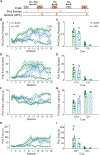Pavlovian cue-evoked alcohol seeking is disrupted by ventral pallidal inhibition
- PMID: 39640360
- PMCID: PMC11619284
- DOI: 10.1016/j.addicn.2024.100186
Pavlovian cue-evoked alcohol seeking is disrupted by ventral pallidal inhibition
Abstract
Cues paired with alcohol can be potent drivers of craving, alcohol-seeking, consumption, and relapse. While the ventral pallidum is implicated in appetitive and consummatory responses across several reward classes and types of behaviors, its role in behavioral responses to Pavlovian alcohol cues has not previously been established. Here, we tested the impact of optogenetic inhibition of ventral pallidum on Pavlovian-conditioned alcohol-seeking in male Long Evans rats. Rats underwent Pavlovian conditioning with an auditory cue predicting alcohol delivery to a reward port and a control cue predicting no alcohol delivery, until they consistently entered the reward port more during the alcohol cue than the control cue. We then tested the within-session effects of optogenetic inhibition during 50% of cue presentations. We found that optogenetic inhibition of ventral pallidum during the alcohol cue reduced port entry likelihood and time spent in the port, and increased port entry latency. Overall, these results suggest that normal ventral pallidum activity is necessary for Pavlovian alcohol-seeking.
Keywords: Pavlovian; alcohol; cues; ventral pallidum.
Conflict of interest statement
Declaration of Interest: None.
Figures




Update of
-
Pavlovian cue-evoked alcohol seeking is disrupted by ventral pallidal inhibition.bioRxiv [Preprint]. 2024 Mar 14:2024.03.14.585064. doi: 10.1101/2024.03.14.585064. bioRxiv. 2024. Update in: Addict Neurosci. 2024 Dec;13:100186. doi: 10.1016/j.addicn.2024.100186. PMID: 38559136 Free PMC article. Updated. Preprint.
Similar articles
-
Pavlovian cue-evoked alcohol seeking is disrupted by ventral pallidal inhibition.bioRxiv [Preprint]. 2024 Mar 14:2024.03.14.585064. doi: 10.1101/2024.03.14.585064. bioRxiv. 2024. Update in: Addict Neurosci. 2024 Dec;13:100186. doi: 10.1016/j.addicn.2024.100186. PMID: 38559136 Free PMC article. Updated. Preprint.
-
Recruitment and disruption of ventral pallidal cue encoding during alcohol seeking.Eur J Neurosci. 2019 Nov;50(9):3428-3444. doi: 10.1111/ejn.14527. Epub 2019 Aug 19. Eur J Neurosci. 2019. PMID: 31338915 Free PMC article.
-
Pavlovian-conditioned alcohol-seeking behavior in rats is invigorated by the interaction between discrete and contextual alcohol cues: implications for relapse.Brain Behav. 2014 Mar;4(2):278-89. doi: 10.1002/brb3.216. Epub 2014 Feb 6. Brain Behav. 2014. PMID: 24683519 Free PMC article.
-
Alcohol-seeking and relapse: A focus on incentive salience and contextual conditioning.Behav Processes. 2017 Aug;141(Pt 1):26-32. doi: 10.1016/j.beproc.2017.04.019. Epub 2017 May 1. Behav Processes. 2017. PMID: 28473252 Review.
-
Alcohol Craving and Relapse Prediction: Imaging Studies.In: Kuhn CM, Koob GF, editors. Advances in the Neuroscience of Addiction. Boca Raton (FL): CRC Press; 2010. Chapter 4. In: Kuhn CM, Koob GF, editors. Advances in the Neuroscience of Addiction. Boca Raton (FL): CRC Press; 2010. Chapter 4. PMID: 21656973 Free Books & Documents. Review.
References
-
- Carpio MJ, Gao R, Wooner E, Cayton CA, Richard JM (2022) Alcohol availability during withdrawal gates the impact of alcohol vapor exposure on responses to alcohol cues. Psychopharmacology Available at: https://pubmed.ncbi.nlm.nih.gov/35881146/ [Accessed September 11, 2022]. - PMC - PubMed
Grants and funding
LinkOut - more resources
Full Text Sources
